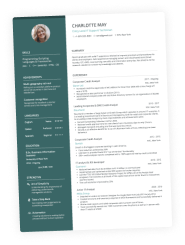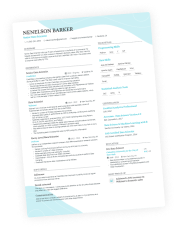Looking to move up without moving out? Internal job opportunities can offer you the career growth you’re seeking—without having to start from scratch. But just because you're a known quantity doesn't mean you can rely on your reputation alone.
If you want to stand out for a promotion or a lateral move, you’ll need a strategic, polished resume tailored for internal positions. This guide will show you how to present your experience in a way that aligns with your company's future, highlights your growth, and puts you at the top of the internal candidate list.
Key takeaways
- Internal resumes should underline company-specific contributions and transferable skills.
- An advantage of using internal recruitment to fill job positions is reduced hiring costs and faster onboarding.
- Recommendations from colleagues or supervisors can greatly enhance your application.
- Avoid a casual tone, assumptions, or skipping the formal process.
- Cover letters for internal positions should express genuine interest and connect past achievements to future impact.
Why internal positions deserve a special resume
To understand what sets an internal application apart, it's essential to first recognize how internal roles are evaluated differently from external ones. This section explains why your internal resume needs to be more than a repeat of your employee file.
When applying for an internal position—whether in operations, internal medicine, or marketing—your resume needs to reflect not just what you've done, but how well you understand the company's culture, goals, and expectations.
A good internal control procedure includes rotating employees into different positions to develop new skills, and your resume should demonstrate you're ready for that growth.
Applying internally gives you the edge of familiarity and existing relationships. Use this to your advantage by tailoring your resume for an internal position, positioning yourself as both a proven performer and a forward-thinking contributor.
What is an internal resume?
Now that you understand why internal resumes require a different approach, let’s break down what they are and how they differ structurally and strategically from resumes used for external job searches.
An internal resume is a targeted document designed to showcase your current contributions and your readiness for a new challenge within the same organization. It's distinct from a typical external resume because it assumes some shared understanding, yet it must still be formal, complete, and achievement-focused.
To craft an effective internal resume:
- Highlight contributions tied to company success.
- Showcase projects that illustrate transferable skills.
- Include any relevant insider knowledge of workflows or tools.
- Use a structure such as the reverse-chronological resume or combination resume to organize your experience effectively.
Benefits of internal recruitment (for you and the company)
Understanding how internal recruitment benefits the business—and not just your career—can help you frame your application more persuasively. This next section outlines why companies are often eager to promote from within.
From the employer’s perspective, one major advantage of using internal recruitment to fill job positions is the reduced cost and time required for onboarding. It also boosts retention, morale, and productivity, especially when employees see real chances for advancement.
From your perspective, applying internally means you:
- Already understand company culture and expectations.
- Have access to insider knowledge that others don’t.
- Can hit the ground running in a new role.
- Reinforce your value and loyalty through your application.
Hiring internally helps preserve company culture and ensures smoother transitions. It also encourages cross-department learning and innovation, often leading to creative solutions and improved teamwork.
How to create an outstanding resume for an internal position
You’ve seen the value of internal hiring—now let’s focus on what makes an internal resume truly effective. This section walks you through the tactical steps to building a standout resume.
Quantify and contextualize your impact
Don’t just list job duties—show outcomes. For instance, "Reduced processing time by 30% through automation" is more persuasive than "Managed data entry."
Use resume bullet points that start with action verbs and quantify results wherever possible. Refer to our guide on how to quantify achievements to improve your impact statements.
Talk to people in the know
Talk to people in the know—reach out to HR or colleagues already in the role to get insider insight. It can help you tailor your resume, ask smarter questions, and show you're serious about the move.
Tailor it to the target role
Start with the job description. Identify keywords and requirements. Use those terms in your resume to make it ATS-friendly and to clearly show you're aligned with the new role. A tailored resume can make all the difference.
Include internal recommendations
Consider a short quote from a supervisor or mention strong endorsements from performance reviews. These lend third-party credibility to your resume.
Highlight soft skills and teamwork
Hard skills might get you noticed, but soft skills often win internal roles. Emphasize collaboration, adaptability, and communication.
Use a clean, professional layout
Stick with a refined resume format with consistent resume margins, resume fonts, and a clear resume layout. Avoid overusing resume icons or resume colors unless applying to creative teams.
Skip the generic career summary—your internal resume isn’t a blind intro, it’s a power play. Focus on the impact your colleagues already know you for, and frame it like you're reminding them why promoting you is a no-brainer. Forget the fluff—this is your chance to connect the dots between what you’ve done and where the team needs to go.
Writer’s take
Customizing skills and qualifications for the target role
Once your resume’s structure is in place, the next step is tailoring the content—particularly your skills section, qualifications, and experience—to match the job you’re applying for. This ensures your resume speaks directly to the hiring manager's needs.
To effectively align your resume with the target role:
Start with the job description
- Identify key requirements such as certifications, technical skills, or quantifiable results.
- Look for recurring language or phrasing that signals what's most important.
Match your achievements accordingly
- Pull examples from your work history that demonstrate how you've met similar demands.
- Prioritize accomplishments that go beyond job duties—emphasize results and impact.
Refine your professional profile or summary
- Open with 2–3 concise lines that highlight your value in context.
- Use this section to introduce your relevance before diving into a detailed experience.
Balance technical and interpersonal skills
- In the experience section, pair hard skills (e.g., software proficiency, data analysis) with soft skills (e.g., team leadership, client communication).
- Frame each skill with context and outcomes where possible.
Use industry-specific keywords
- Incorporate terms from the job listing to optimize for applicant tracking systems (ATS).
- This not only boosts visibility but signals to hiring managers that you're fluent in the field.
In summary, aligning your resume content with the role’s expectations sets the foundation for a compelling application package.
To see these strategies in action, let’s walk through a resume example that applies them in a clear and compelling way.
Jessica Chen
Email: jessica.chen@company.com | Phone: (555) 123-4567 | LinkedIn: linkedin.com/in/jesschen | Location: Austin, TX
Current Position: Marketing Specialist, Acme Corp | Years at Company: 3 years
Objective
To transition into the Senior Marketing Manager role at Acme Corp, leveraging three years of performance-driven marketing strategy, cross-department collaboration, and successful campaign leadership to elevate brand visibility and customer engagement across channels.
Summary of Qualifications
- Internal impact: Spearheaded 3 cross-functional campaigns that led to a 25% increase in qualified leads over 12 months.
- Strategic thinker: Played a key role in restructuring email marketing workflows—cutting content production time by 30%.
- Team leadership: Mentored two junior marketers, both of whom received internal promotions in the past year.
- Results-oriented: Consistently exceeded KPI goals in lead generation, content performance, and conversion rates.
Experience
Marketing Specialist
Acme Corp – Austin, TX | July 2022–Present
- Collaborated with product and design teams to launch targeted product campaigns, generating a 40% lift in trial signups for Q3 2023.
- Developed and implemented a lead-nurturing email series that improved open rates by 18% and reduced churn by 12%.
- Partnered with Sales Ops to optimize our CRM tagging system, improving campaign segmentation accuracy by 35%.
- Initiated monthly marketing analytics syncs to align team priorities with real-time performance data.
- Coordinated internal marketing training programs, increasing team adoption of MarTech tools by 60%.
Key Achievements:
- Awarded “Team Collaborator of the Quarter” for cross-department leadership on the Summer '23 product launch.
- Selected to represent the marketing team in the company-wide strategy planning committee (2024).
Additional Roles and Projects at Acme Corp
- Marketing Mentor Program Lead (2024–present): Designed a structured peer mentorship program that boosted engagement and retention within the marketing department.
- DEI Working Group Member (2023): Helped facilitate inclusive language guidelines now used across company communications.
Education
Bachelor of Business Administration (Marketing)
University of Texas at Austin – Graduated: 2019
Skills
- CRM Systems (HubSpot, Salesforce)
- Email Automation (Mailchimp, Iterable)
- Google Analytics, Looker Studio
- Campaign Strategy & A/B Testing
- SEO Content Planning
- Internal Communication & Stakeholder Management
Professional Development
- Advanced Marketing Analytics – Coursera (2023)
- Leadership Essentials Workshop – Acme Corp Internal Training (2024)
- SEO for Growth – Moz Academy (2022)
References
Available upon request or from direct managers:
- Rachel Miller, Senior Marketing Manager
- Aaron Thompson, Director of Marketing Strategy
How to write a cover letter for an internal position
A great resume opens the door, but a great cover letter gets you invited in. This section provides best practices for writing a compelling, confident cover letter tailored to an internal role.
A strong cover letter for an internal position connects your history with the company's future.
Start with enthusiasm for the role, then:
- Explain why the position excites you.
- Highlight relevant achievements and link them to the job’s goals.
- Reference shared company values.
- Request a conversation or meeting.
Example:
Subject: Application for Senior Content Strategist Role
Dear Morgan,
I’m thrilled to apply for the Senior Content Strategist position on the Growth Team. Since joining Acme Corp three years ago, I’ve had the privilege of helping shape our brand voice across multiple channels—and I’m energized by the chance to do that on a larger, more strategic scale.
What draws me most to this role is the opportunity to lead initiatives that push our content beyond awareness and into real business impact. As a Content Writer, I’ve already collaborated closely with Product and Lifecycle teams to launch campaigns that increased email engagement by 42% and contributed to a 15% lift in product trials. I see this role as a natural next step to leverage that momentum and help drive even stronger cross-functional results.
More than metrics, I care deeply about how we communicate—clearly, honestly, and always with the user in mind. That value has guided me here from day one, and it’s one I know we share across teams.
I’d love the opportunity to discuss how I can continue supporting Acme’s growth in this new capacity. Thank you for your time and consideration.
Warm regards,
Jessica Chen
PRO TIP
Still need some help? Check out Enhancv’s free AI Cover Letter Generator!
Pitfalls to avoid in internal applications
Even seasoned employees can stumble during the internal application process. This section highlights common missteps that could jeopardize your chances—and how to avoid them.
- Skipping the process: Always follow the full application procedure.
- Being too casual: Keep your language professional, even if you're applying to a familiar team.
- Overlooking updates: Your resume should reflect your latest accomplishments.
- Using vague achievements: Avoid generic phrases; instead, focus on measurable contributions.
- Assuming familiarity: Not everyone reviewing your resume may know your work.
Frequently asked questions and best practices
| Question | Answer |
|---|---|
| How should I address employment gaps? | If you’ve had periods away from work, briefly explain them in your resume or cover letter without going into unnecessary detail. Focus on what you learned or achieved during those periods, whether through education, certifications, or volunteer work. |
| Should my resume include a resume profile? | Only if it’s targeted and meaningful. Generic descriptions waste space. Instead, consider a resume summary that ties your past performance to future company needs. |
| How long should an internal resume be? | In most cases, a one-page resume is sufficient, especially if your history with the company is well-known. For more senior roles or if your accomplishments span multiple teams or functions, a two-page resume is acceptable. |
| Can I include confidential information? | No. Always respect company confidentiality. If referencing projects, speak in terms of outcomes rather than proprietary details. |
| How often should I update my internal resume? | Ideally, after every performance review period. Keep a running list of new skills, achievements, or certifications that arise. |
| What about the education section? | Only include important education. Make sure to mention new learning plans, like continuing education or certifications, that make you more likely to get the job. |
PRO TIP
Before applying internally, check your company’s job transfer policies and choose your timing wisely—ideally when your performance is strong and projects are stable. Tailor your resume to the role, and if appropriate, loop in your manager early to build trust and support.
The role of internal mobility in company culture
Promotions aren't just good for the individual—they’re critical to a thriving organization. This section explores how internal mobility strengthens your company and supports broader business goals.
Internal mobility fosters growth, engagement, and diversity. When employees see that they can grow without leaving, it boosts loyalty and morale. It's also a good internal control procedure that enhances innovation by rotating employees into different positions.
Diverse internal promotions also lead to more inclusive leadership teams, helping break down silos and improve long-term retention. Promoting from within saves costs, shortens ramp-up time, and ensures stronger cultural alignment.
Don’t assume they know you—prove your growth
Even if you're well-known in the company, treat the internal interview as a chance to reintroduce your professional value. Others may know your role, but not your full impact or future goals. Clearly highlight your achievements, growth, and readiness for the new role.
If you're unsure how to inform your manager that you've applied for an internal position, be honest and respectful. Frame it as a step toward growth within the organization, not a move away from your team. Transparency shows maturity, builds trust, and strengthens your position as a candidate who’s both thoughtful and committed.
What to do:
- Prepare quantifiable examples of your impact across departments or projects.
- Show how you've grown since you joined the company—skills developed, responsibilities expanded, obstacles overcome.
- Frame your internal knowledge as an advantage (“Because I’ve worked closely with [Team X], I’m ready to...”).
- Ask insightful questions that demonstrate a forward-looking mindset and commitment to the company’s broader goals.
Why it matters:
This proves you're not just a good fit—you’re ready to level up.
Conclusion
Applying for an internal role offers a unique opportunity to leverage your institutional knowledge and show leadership that you're ready for more. A well-targeted internal resume highlights your growth, accomplishments, and alignment with the company’s goals, while positioning you as the natural choice.
Pair your resume with a tailored cover letter that conveys your enthusiasm and forward-looking perspective. This combination helps you stand out, demonstrates initiative, and reinforces your value as a dedicated team member ready for the next step.
Want to see how your resume stacks up? Try our free ATS Resume Scanner or explore resume tips to optimize your internal application today.
Make one that's truly you.



